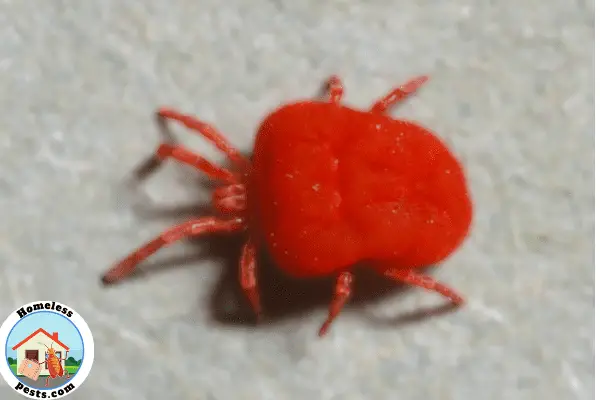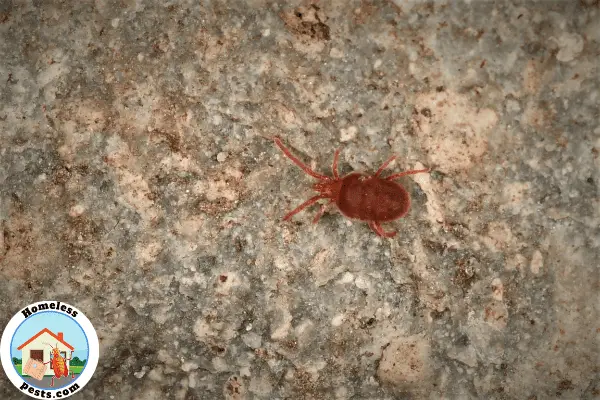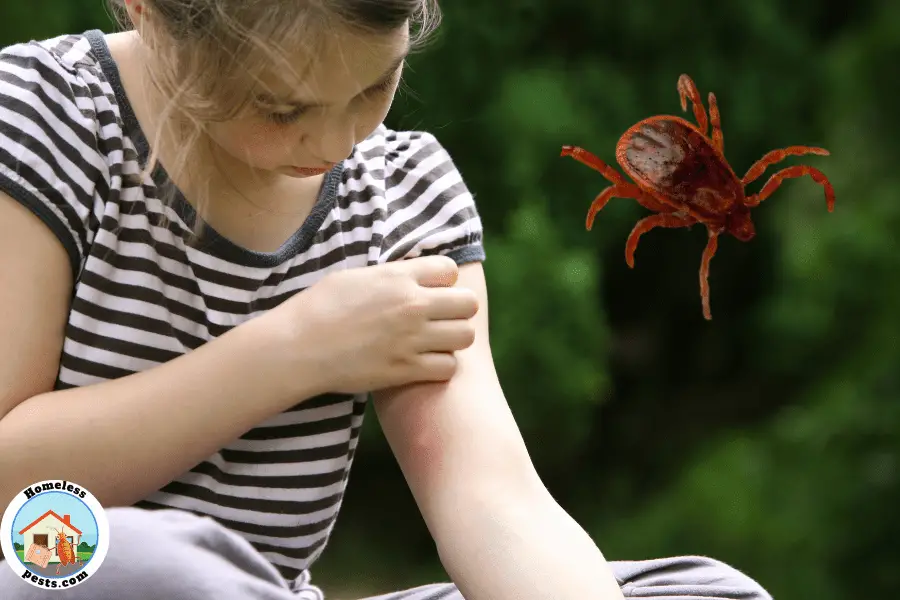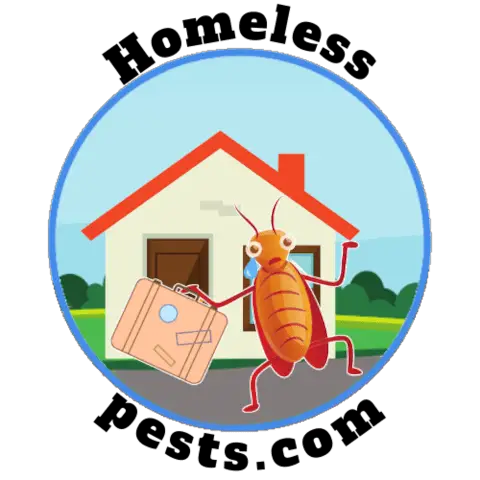Summertime is a great time to be outside, enjoying the warm weather and spending time with family and friends. However, if you’re one of the unlucky people who gets bitten by chiggers, it can quickly turn from a fun summer day into an itchy nightmare!
In this article, I’ll discuss what chiggers are, how to identify them, and how to distinguish their bites from other pests. Plus, I have even more resources to help you reduce the impact these critters have on your family’s fun!
Keep reading for more information.
What is a Chigger?

Chiggers are the larvae (immature stages) of certain mites in the family Trombiculidae. They are also sometimes called redbugs or harvest lice. It’s interesting to note that only the female chigger bites and feeds on animals or humans, which is also the case for mosquitos.
Contrary to popular myths, chiggers do not burrow into the skin (you are thinking of the mites that cause scabies), but they pierce it and insert their feeding tube into small blood vessels.
Once attached to a viable vessel, chiggers will feed for several days, during which time they swell to many times their original size as they fill with blood. After several days, the chigger falls off the host and molts into its next stage of development.
Another interesting thing about these animals is that once they have developed into the next stage of their life cycle they are no longer parasitical but develop predatory characteristics instead. Well, I find it interesting at least!
Chiggers have several characteristics that help to distinguish them from other mites. They are very small, usually less than 1/150 of an inch (0.17 mm) long. Chiggers are yellowish-orange or red and have six legs during this phase of life (all other mites have eight legs as adults).
The front two legs of the chigger are much larger than the back four legs and end in sharp claws. Chiggers also have a short, stubby body that is widest in the middle and tapers towards the ends.
Where will you find chiggers in your area?

Chiggers are found in many areas of the world, including the United States, where they are most common in the southeastern states. However, you will find them popping up in almost all states with two exceptions. (Read my full article about where to find chiggers in the USA).
Chiggers generally live in grassy, brushy, or wooded areas and are often found near ponds or streams. They commonly infest lawns, parks, golf courses, and other recreational areas. Chiggers can also be found in wooded areas, around stumps or fallen logs, and in leaf litter.
When exploring these areas between spring and summer, it’s best to take precautions against chiggers. I go over some prevention and treatment options for chigger bites in my article all about chigger bites.
Where will chiggers hang out in your home?
In my experience, you are much more likely to fall victim to a chigger and its itchy bite while outside. Nevertheless, these little bugs do often find themselves in the homes of Americans.
In fact, it’s easier to have a chigger infestation than you might think. All it takes is for one of the arachnids (yep, technically not an insect) to hitch a ride on your clothing or shoes and into your house, they go. Once inside, they’ll usually stay close to where they came in.
So, after you’ve had a long walk through tall grass in the local woods, you might want to take a close look at your mudroom or foyer – that’s likely where you’ll find any chiggers that have hitched a ride from the outdoors.
As for getting rid of them, regular vacuuming and dusting can help get rid of any chiggers that might be present in your home. These bugs are actually quite slow-moving, unlike fleas or cockroaches, and an instant laundry wash and a shower is a good way to get rid of them too.
If your backyard is attractive to chiggers, they can also wander into your home from there. Be sure to keep the grass trimmed and remove any piles of leaves or other organic debris. These are all potential homes for chiggers, so by keeping your yard clean, you can help prevent an infestation in your home.
It’s also a good anti-pest policy to check your home each year (or a couple of times) for even the tiniest of entry points. Caulk any cracks in your foundation or seal any gaps around doors and windows to help keep these (and other) pests out.
Also, check your basement and garage for water leaks and dampness because this environment will be a haven for chiggers (and many insects too).
If you do find chiggers in your home, don’t hesitate to call a professional exterminator. While these pests are not dangerous, they can be quite a nuisance. A good pest control company will be able to get rid of them quickly and efficiently.

What does a chigger bite look like?
Chigger bites usually appear as small, red bumps on the skin. The bumps may be raised or flat and are often clustered together in a small area. Unlike mosquito bites, which are typically painless at first, chigger bites are often quite itchy. I’ve actually spent quite a bit of time putting together a full article about identifying chigger bites, so you can learn more by reading it.
In some cases, the itching can be so severe that it leads to secondary infections from scratching. If you have any doubts about what has bitten you or you are finding it extremely uncomfortable, visit your local pharmacy or doctor for more advice.
How to identify a chigger (bites and other pests)

If you or a member of your family has been bitten by some nasty bug, you may assume it’s a chigger. However, sometimes their bites can be easily confused with the bites of other bugs or insects. So, below I’d like to briefly take you through some of the commonly misidentified insect bites.
Clover mites vs chiggers Bites
Clover mites bites are quite different compared to the chigger bites. For one, clover mite bites are not itchy. In fact, you might not even feel them. And two, clover mites feed on plants—not animals or humans as chiggers do.
So if you have been bitten, it’s certainly by some other type of bug.
Seed ticks vs chiggers bites
Seed tick bites also look quite different from chigger bites. Seed ticks are larger—about the size of a freckle or small mole. And their bites tend to be more raised and red, with a small white center. They also tend to occur in groups, which can be the reason they get confused with chigger bites, which also present in small groups as several chiggers may feast together in the same area.
.
Chiggers vs mosquito bites
Chigger bites can be mistaken for mosquito bites. Both insect bites will appear as red, raised bumps on the skin. However, there are a few key differences. Chigger bites are usually much itchier than mosquito bites. Additionally, chigger bites tend to occur in groups of three or more, whereas mosquito bites are usually singular.
I once had a mosquito bite that was so swollen my entire elbow grew by at least three times. A chigger bite wouldn’t normally result in such swelling in such a short period of time.
Chinch bugs vs chiggers bites
Perhaps the most difficult bites to distinguish are those between chinch bugs and chiggers. Both insect bites will appear as red, raised bumps on the skin. However, chinch bug bites are usually much itchier than chigger bites (which themselves are very itchy).
Another area of confusion is that both chinch bug bites and chigger bites tend to occur in groups of three or more. That being said, if you have only been intercepted by a sole chigger, you will only receive one bite area.
Chiggers vs fleas bites
Chigger bites can be and often are mistaken for flea bites. Just like many similar insect bites, these two animals will give you bites that appear as red, raised bumps on the skin. However, there are a few key differences. Chigger bites are usually much itchier than flea bites. Additionally, chigger bites tend to occur in groups of three or more, whereas flea bites are usually singular and far less concentrated.
Chiggers vs bedbugs bites
Another common misidentification is the bites of bedbugs and chiggers. If you are bitten by either species you will have the same red and raised bumps in a similar way as many bites present.
If you are ‘fortunate’ enough to be bitten by a bed bug, you won’t suffer quite as much as if a chigger bit you. You’ll also find bed bugs tend to attack you all over your body, whereas chiggers rarely make it much farther than the tops of your legs.
Chiggers vs mites bites
It can be quite difficult to tell if you’ve been bitten by a chigger or a mite unless we are talking about Sarcoptes Scabiei. The bites from both animals will appear as irritated, raised bumps on the skin and they can both be pretty itchy wounds to receive.
If you have been attacked by the Sarcoptes Sabiei mite, then the bites will spread all over your body if left untreated. Scabies is caused by a burrowing mite, whereas chiggers (juvenile mites themselves) only bite into the skin. If the bite areas seem to be spreading, contact your doctor quickly.
Poison ivy vs chiggers
Poison ivy is often confused with chiggers. Poison ivy is a plant that can cause an itchy rash when the sap comes into contact with the skin. Chiggers are tiny arachnids that bite humans and animals, causing an itchy rash. While both can cause an itchy rash, they are not the same thing.
Other Characteristics of Chiggers you should Know

Are Most Active During Summer
Chiggers tend to be most active during the summer months. This is because their preferred host, white-tailed deer, is also most active during this time. As a result, chiggers are more likely to be found in areas where there is a high density of deer.
They Are Attracted to Movement
Chiggers thought slow movers themselves, will sense when wild game is moving and will position themselves to intercept these potential hosts. Of course, these little arachnids cannot tell the difference between you or your pet moving through long grass and their preferred wild hosts.
When they sense movement, they will move towards it in the hopes of finding a suitable place to snack. So avoiding long grass and brushland is a must.
They Are Found in Wooded Areas
Chiggers love to hang out in forests, pretty much anywhere with lots of trees. This is because their preferred host, white-tailed deer, is also most often found in these areas.
Of course, these woodlands don’t need to be in the middle of the wilderness. Your local park or footpath can be teeming with chiggers just waiting for a ride.
They Are Not Contagious
Chiggers are not contagious. This is because they do not transmit any diseases. Additionally, they only attach to the skin for a short period of time before falling off.
However, you can certainly get infected wounds if you scratch the bites too much. This is why you need to treat the bites as soon as you notice them and get the itchiness under control.
They Do Not burrow Into the Skin
One of the most common misconceptions about chiggers is that they burrow into the skin. This is not true. Chiggers only attach to the skin for a short period of time before falling off. If you have a burrowing mite in your skin, then you are falling victim to Sarcoptes Scabiei.




